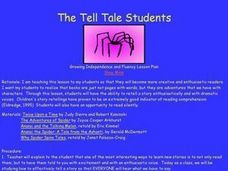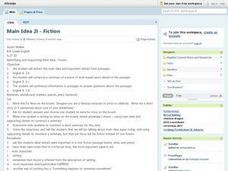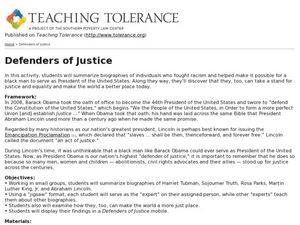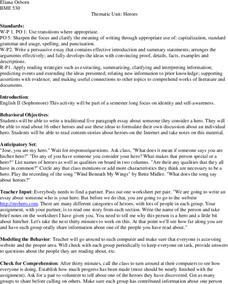Curated OER
The Tell Tale Students
Young scholars practice summarizing text by retelling what they have read. They read selected, leveled passages and use enthusiastic and createive ways to members of their group. Students complete a journal entry documenting their...
Curated OER
Main Idea- Fiction
Eighth graders investigate the concept of main idea and supporting details, and how they are used in the genre of fiction. In this literacy lesson, 8th graders listen to a fictional passage and take notes on the characters, setting,...
Curated OER
Begin Reading Seedfolks
Learners are introduced to the book Seedfolks and the concept of community. In this Seedfolks literature study lesson, the first in a unit, the teacher reads the first half of the book and students answer comprehension questions and...
Curated OER
Technology-commected Folklife Lesson Plan: Fables
Learners discuss ways the stories were alike and different. The teacher demonstrate how to draw a Venn diagram using Microsoft Word. They label the two circles and enter the likenesses and differences on the diagram.
Curated OER
Inferring Themes
Fifth graders practice making inferences on various types of reading material. As a class, they develop a definition of the word "theme" and discuss themes for some of their favorite stories. They use the context of the reading...
Curated OER
Organizing Main Ideas and Supporting Details
Students read given information and identify the main ideas and specific detail of the story. In groups, they read a historical title and create a "book talk" for each one, summarizing the story. In addition, students create a...
Curated OER
Writer's Workshop
Fifth graders explore and examine the book, "The True Story of the Three Little Pigs," by Jan Scieszka. They assess that an author's voice and individual style is an important part of keeping a person interested in a story. Each student,...
Curated OER
Preparing the Soil
Middle schoolers explore philanthropy through literature. In this service learning activity, students consider character traits as they read Seedfolks. Middle schoolers record their notes regarding the characters in the story of a...
Curated OER
Discovering the Oregon Trail
Students explore U.S. history by researching the Oregon Trail. In this American exploration lesson, students read the story On the Shore of the River and define the exact path early settlers took to find the state of Oregon. Students...
Curated OER
Danger on the Underground Railroad
Student examines the role of the Underground railroad. In this Post-Civil War lesson, 7th graders read and analyze primary sources. Students create a timeline that details the events of the stories.
Curated OER
Painting Pottery
Students summarize and illustrate the process of painting an ancient Greek vessel, identify the amphora as an example of the black figure style and order the steps and procedures necessary to produce an amphora in the black figure style.
Curated OER
Defenders of Justice
Students research abolitionists, civil rights advocates, and their allies to learn about racism and justice. In this racism and justice lesson, students define justice and sing a song about activism. Students review the biographies...
Curated OER
Kate Fowler: Tory Spy
Fourth graders study the American Revolution and several key aspects and people involved in it. In this American Revolution lesson, 4th graders study the land grant for British colonists. Students read the 'The Legend of Kate Fowler' and...
Curated OER
The Very Hungry Caterpillar
First graders, after reading The Very Hungry Caterpillar, place the story in its correct order of sequence. They place any set of events (situation) in their correct order.
Curated OER
Geography in the News
Ninth graders are introduced to an article in which falls into one of the five themes of geography. They pick their own article and summarize it to the class.
Curated OER
Natural Resources
Students use magazines and newspapers to examine the Earth's natural resources. They identify ways that natural resources are protected, threatened, managed and mismanaged. They find the location of each story on a world map and...
Curated OER
Nursery Rhymes
Students recall details of nursery rhyme read by teacher, identify main characters, and demonstrate knowledge of poem by creating concept map about story that includes title, clip art, and changes in font and color.
Curated OER
Using "Why Mosquitoes Buzz in People's Ears" to Teach Cause and Effect
Students discuss cause and effect relationships and the chain reaction involved before listening to the story "Why Mosquitoes Buzz in People's Ears". Students create flow charts to show the chain reactions of causes and effects in the...
Curated OER
Where Does Water Come From: The Water Cycle
Students explore the water cycle. In this water cycle lesson, students read the book The Magic School Bus Wet All Over and summarize the steps of the water cycle. Students label a picture map of the water cycle.
Curated OER
The Mighty Oak
Students investigate types of trees. In this forestry lesson, students read the book The Mighty Oak and act out the story with a partner. Students discuss the types of trees in the book and plant an oak tree on school grounds.
Alabama Learning Exchange
Leo Lionni’s Little Blue and Little Yellow
Students use the Internet to research the author Leo Lionni, then rewrite and illustrate one of his stories.
Curated OER
Heroes
Tenth graders participate in research and class discussion before attempting to write a traditional five paragraph essay. They use the examples of 16 other hero stories to consider. Students use examples and descriptive details to...
Curated OER
Sadako and the Thousand Paper Cranes
Third graders explore their culture in comparison to Japanese culture by reading the book, Sadako and the Thousand Paper Cranes. They identify islands of Japan, create a Venn diagram comparing Japanese culture to American culture, and...
Curated OER
Irony At Owl Creek
Students engage in study of literature in order to identify the use of irony in the context of reading two stories. They are compared and contrasted and the irony is exposed. The activities include the answering of several key questions.

























